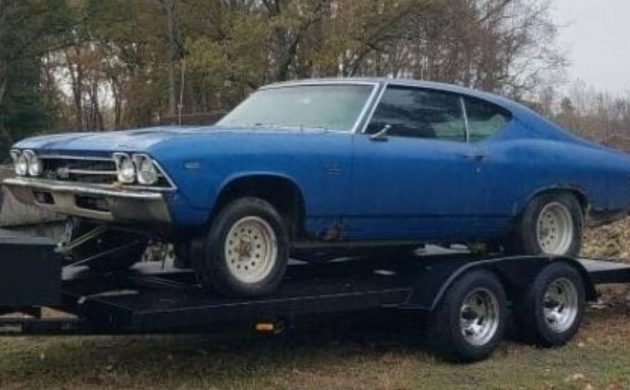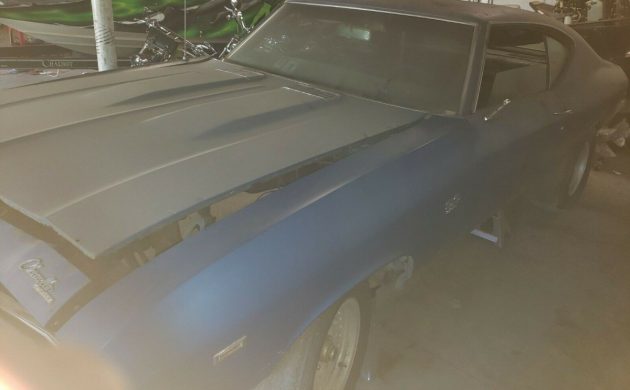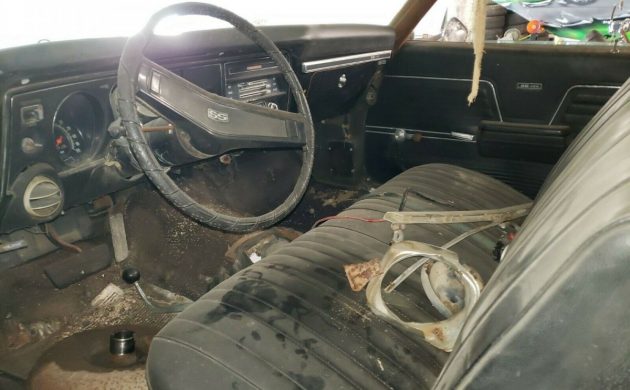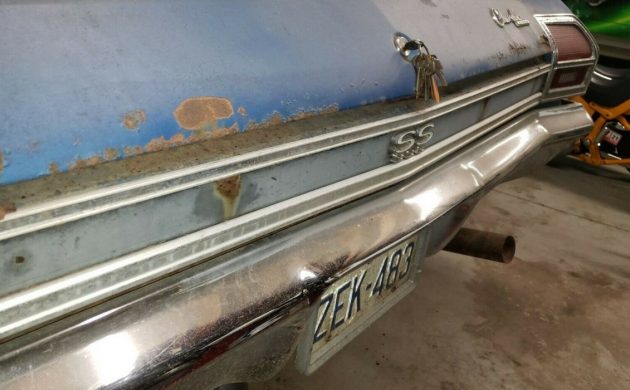A 1969 SS396 Chevelle has become one of the all-time uber collectible muscle cars. Quite a few have wended their way through the pages of Barn Finds and many are often in a similar condition to this example – rode hard and put away wet. The seller states that it was a father & son project but the son lost interest so it’s time to part ways with the Chevy. Let’s see if there is more to the story. This Chevelle is located in Aylett, Virginia and is available, here on eBay for a current bid of $5,800, reserve not yet met.
In all fairness to this Chevelle, it is over half a century old and its lot in life was pretty much to be beaten upon. The original owners, in most instances, did just that and subsequent owners continued the mayhem. Many Chevelles ended up modified for the track but the modifications weren’t always performed particularly well, leaving a permanently altered car. Then, the post-race world came about and the car could not be easily returned to some semblance of street or cruising use. To make matters worse, the car was then left outside under that familiar boast of, “No, I don’t want to sell it, I’m gonna’ restore it”, an undertaking that never came to pass. There would have been a time when the outside adventure would have amounted to three strikes, and that Chevelle was over and out for good. But with market values that are nothing short of nuckin’ futz and a plethora of every imaginable new part available, cars like a ’69 SS396 compete with cats for who has more lives. This example will probably continue in that vein.
First up, this example is a roller, no engine. The seller states that it has 4.56 rear gears so it was probably set up for drag racing with an aggressive engine. As to which engine, it’s hard to say. SS396s came in 325, 350, and 375 HP versions, and the 325s, with their very heavy cast iron crankshaft, were not a good basis for heavy modification and the resulting high RPMs. Of course, that didn’t stop many… Inside, an A/C vent is visible so that negates the 375 HP option. And 4.56 gears, as unstreetable as they are, are the bane of a big-block engine unless quarter-mile passes or traffic light to traffic light stomping was the intended plan. How it was powered is probably irrelevant as 51 years is a long time, so this Chevelle could have harbored numerous powerplants over its long life. This is an automatic transmission car and the Turbo-Hydramatic 400 gearbox is included in the sale – good to know as a used T-400 with a Chevrolet bell housing bolt pattern, opposed to the more common B-O-P pattern, has become a bit scarce as of late.
Call it built-in obsolescence, doing things on the cheap or just slap-dash assembly, a Chevelle “A” body, and its corporate cousins at Buick, Oldsmobile, and Pontiac were designed to rust. Unless the car was domiciled in the driest of conditions, like parts of California, or the southwest, finding one that has not been invaded by rust is a challenge. This example is, unfortunately, all too typical as there are layers of Bondo slathered over some serious corrosion and then there are other rust spots that have been left to fester. And on top of that, this Chevy looks like it has had a cheap respray applied at some point in its life. With these few topside observations, it makes one wonder what’s going on underneath with the frame, inner rockers, and floors. Panel replacement, either full or partial depending on the extensiveness of the rot, is the only way to cope with this kind of degradation. Beyond the noted, obviously, the front end, grille, headlights, etc. needs help.
The interior of this Chevelle, like many project cars, has become a storage area for all of the remaining detritus; things like a torque converter, headlight trim, headers, and other unidentifiable stuff. This Chevelle came with a bench seat and a column-mounted gear selector, not that unusual, but less desirable than the bucket seat/center console combo. It appears that this car has been converted to a floor-mounted shift selector but it’s hard to get a comprehensive look at the interior’s overall condition. The seat upholstery does not appear to be split or torn but there’s no telling what kind of goo residue one might find once all of the objects have been removed. The headliner is definitely gravity challenged.
There are four bids pending and it is hard to estimate what the reserve on this Chevelle is; it will move at some point, it just depends on the seller’s reasonableness – he does state, “This was a father & son project but my son lost interest so our loss is your gain!!” I’m just not certain what or where that gain will be, any ideas?







“Lost interest” Hmmm… In this case, more likely never had any interest in the first place. Bought, put on jack stands. Walked around. Looked at. No parts bought, no work done. Might be a good thing; at least it was not disassembled and turned into a jigsaw puzzle.
There is no proof this is a real SS or ever spent any time at a race track. Ladder bars and over gearing a car doesn’t mean anything, gears like that and bolt on ladder bars were common on the streets during the 70’s and early-80’s.
Based on the amount of rust and the flaking Bondo I’d say that’s more likely the reason the car is on the market than “my son lost interest”. That’s a tired excuse flippers use that’s in the same vane as “I’m selling it for a relative that doesn’t drive anymore” or “it belongs to a friend without a computer”. Those “reasons” put forth by a seller all have a built in excuse for not being able to answer all but the most basic questions about a cars history as well as put potential buyers at ease.
Based on the cars condition, I’d keep looking until something better comes along.
Steve R
And the keys are in the trunk lock, ready to er… drive it away?
A bit wasted, and it reminds me heavily of my ’68 Chevelle which had been stuffed with a 396 and still had the 327 call outs…primer grey with a primer black hood that sat kinda of up in the back so hot air could escape, Ha ha ha, even painted it dark metallic blue. Lots of fun, I guess, in 1985.
Odd place for a floor shifter to be mounted?? No….
Any number of engines could have found their way in there over the years,,, even amped up small blocks were used in place of the big block sometimes…with those gears either street/strip or strip duty, maybe real street racing….who cares. What matters now is if its genuinely an SS396 or not due to the overwhelming money they command. The days of what it was are just interesting at best, what it will be…another SS396 Chevelle either real or “added” to the count.
My favorite motor is a big block Chevy, and I have built many for drag racing, sand dragging and street cars, I have a 454 in my 32 Ford roadster to this day. I don’t get your comment “with their very heavy cast iron crankshaft, were not a good basis for heavy modification and the resulting high RPMs” are you kidding I have never seen a factory steel bbc crank in person, every BBC I’ve had used a cast crank and I have never broke one even running on nitrous,(you mention not good for “resulting high rpms” how high do you think you need to buzz a BBC to make power? I would guesstimate 90% of street cars and even drag racing would rarely see the other side 6.5 grand) I take them to 6 grand and they don’t break. Sure for a really strong race motor that would see higher rpms and higher horse power you would want a steel crank, for sure, which would weigh about the same a cast one so it’s not about weight when choosing one over the other it’s a strength issue. And one last note the most poplar motor in all of drag racing is the small block Chevy guess what’s number 2, the BBC and most are modified with cast cranks, OK I’ll now step down from my soap box.
Desert Rat:
Good comments, but I have spun bearings on the cast iron versions at 5,600 RPM – might be the reason the factory tach has the redline set at 5,000 RPM and 5,500 RPM on the 350 & 360 HP versions.
As for forged steel, I’ve encountered many, all of the 350, 360 & 375 HP versions had them and I believe the 325s did too in ’65 and ’66 – they’re not uncommon. Back in the ’70s, when I had my ’67 SS396, I lost count of how many ’66 and ’67s I saw, sitting nose high because the rat had been blown and replaced with a small-block. Actually, just last week I was looking at a ’67 El Camino, one of interest to me, that had met that fate and was now sporting a 350.
It’s good to know that you have had the experience with yours that you have but that’s not been my experience.
Thx,
JO
Interesting conversation about cranks.
In the early 70’s, I bought a ’69 SS Chevelle with a bad bottom end. Put in a cheap motor for a while, but spent the money to have the original block align-bored. The crank I picked up from a friend was steel, out of a wrecked/parted out Corvette. Got the cam too. The original iron crankshaft could have been reground, I was told, but buying the steel one and having the machine work done on it seemed like a much better option.
Speaking of a Chevelle, find a big one, dig a deep hole, and bury it.
I realize it was in the mid 80s, but this clearly shows how muscle cars have increased in value. I bought a near perfect, totally rust free 1970 California born and raised GTO for $5,500. When I took it to my local mechanic for Pennsylvania state inspection, with the California plates still on the car, he asked how much I paid. I told him. Even then, he could not believe it. GM made 50 million Chevelles. Keep looking.
The author beat me to all of my usual pet peeves. I agree that GMs A body was designed to return all of its steel parts back to the earth. The author also mentions the “don’t want to sell it”, “gonna restore it someday”, only to jump ship and completely change course when they realize that their car project that could have brought him a nice profit is now a car project that strongly resembles swiss cheese. And, last but not least, the original engine is missing. I would like to meet the person who thought that some other vehicle deserved a Chevelle’s big block more than the Chevelle did. Car guys are supposed to remove the desirable engines from the non desirable vehicles and put them in a desirable vehicle, not vice versa.